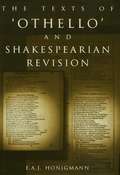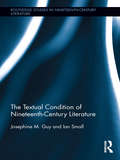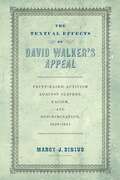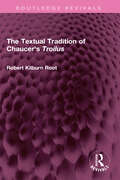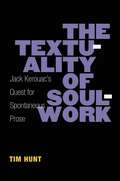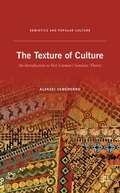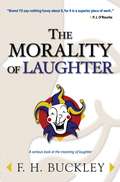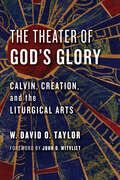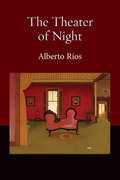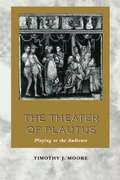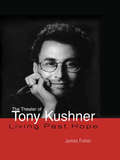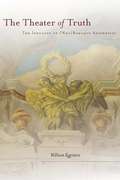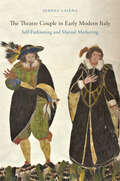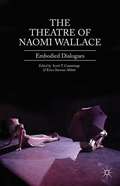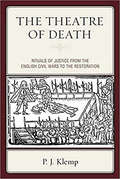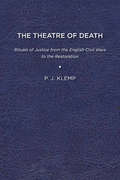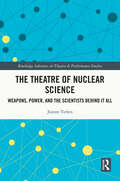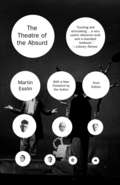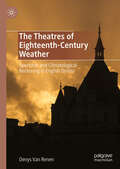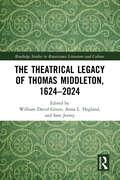- Table View
- List View
The Texts in Elementary Classrooms
by James V. Hoffman Diane L. SchallertThis CIERA sponsored book is based on the premise that high-quality texts of all kinds are essential to good teaching in elementary classrooms. Experts on a variety of text-related topics were asked to summarize existing research and then apply it to literacy development in an "ideal" classroom. The most comprehensive and up-to-date book in its field, it moves progressively from an examination of discrete literacy processes and forms to a holistic overview and assessment of the classroom literacy environment. Content coverage in this outstanding new book includes: *Literacy Processes--Part I examines basic reading processes (instruction, comprehension, word recognition, fluency, and motivation) as they relate to text features.*Forms of Texts--Part II examines the wide variety of text types (fiction, nonfiction, leveled, local, and electronic) that comprise an effective classroom literacy program. Discussions include the nature of these texts, their qualities and quantities, how they fit into an instructional plan, and how a teacher might assess their effectiveness.*Text Selection--Part III examines special issues (linguistic diversity and teachers as censors) related to the selection of classroom texts.*Personal Applications--The final, hands-on chapter synthesizes the book's ideas and offers practical tools (checklists and inventories) whereby teachers can self-assess the literacy environment of their own classrooms.This book is suitable for anyone (graduate students, in-service reading specialists and curriculum directors, college faculty, and researchers) who deal directly with issues of classroom literacy.
The Texts of Othello and Shakespearean Revision
by E. A. HonigmannIn a groundbreaking piece of scholarly detective work, Professor Honigmann - editor of the forthcoming Arden 3 edition of Othello - uncovers in more detail than any previous study the hidden history of the two early texts of Othello, the Quarto and the Folio. He traces the crucial role played by two men in transforming Shakespeare's almost illegible manuscript to print: Thomas Walkley, the publisher of the Quarto, and Ralph Crane, the scribe who prepared the printer's copy for the Folio. Through careful analysis of particular passages Honigmann exposes the extent to which versions of Othello adopted by editors and widely regarded as fundamentally 'Shakespearean' were profoundly influenced by others than Shakespeare himself. Questioning time-honoured editorial procedures the findings of Texts of Othello have implications for many other of the plays of the Shakespeare canon, and more widely for questions of authorship and the doctrine of the 'better text'.
The Textual Condition (Princeton Studies in Culture/Power/History #7)
by Jerome J. McGannOver the past decade literary critic and editor Jerome McGann has developed a theory of textuality based in writing and production rather than in reading and interpretation. These new essays extend his investigations of the instability of the physical text. McGann shows how every text enters the world under socio-historical conditions that set the stage for a ceaseless process of textual development and mutation. Arguing that textuality is a matter of inscription and articulation, he explores texts as material and social phenomena, as particular kinds of acts. McGann links his study to contextual and institutional studies of literary works as they are generated over time by authors, editors, typographers, book designers, marketing planners, and other publishing agents. This enables him to examine issues of textual stability and instability in the arenas of textual production and reproduction. Drawing on literary examples from the past two centuries--including works by Byron, Blake, Morris, Yeats, Joyce, and especially Pound--McGann applies his theory to key problems facing anyone who studies texts and textuality.
The Textual Condition of Nineteenth-Century Literature (Routledge Studies in Nineteenth Century Literature)
by Ian Small Josephine GuyIn this important new book, Guy and Small develop a new account of literary creativity in the late nineteenth century, one that combines concepts generated by text-theorists concerning the embodied nature of textuality with the empirical insights of text-editors and book historians. Through these developments, which the authors term the ‘textual turn,’ this study examines the textual condition of nineteenth-century literature. The authors explore works by Dickens, Wilde, Hardy, Yeats, Swinburne, FitzGerald, Pater, Arnold, Pinero and Shaw, connecting questions about what a work textually ‘is’ with questions about why we read it and how we value it. The study asks whether the textual turn places us in a stronger position to analyze the value of a nineteenth-century text—not for readers of the nineteenth century, but of the twenty-first. The authors argue that this issue of value is central to their discipline.
The Textual Effects of David Walker's "Appeal": Print-Based Activism Against Slavery, Racism, and Discrimination, 1829-1851 (Material Texts)
by Marcy J. DiniusHistorians and literary historians alike recognize David Walker's Appeal to the Coloured Citizens of the World (1829-1830) as one of the most politically radical and consequential antislavery texts ever published, yet the pamphlet's significant impact on North American nineteenth-century print-based activism has gone under-examined. In The Textual Effects of David Walker's "Appeal" Marcy J. Dinius offers the first in-depth analysis of Walker's argumentatively and typographically radical pamphlet and its direct influence on five Black and Indigenous activist authors, Maria W. Stewart, William Apess, William Paul Quinn, Henry Highland Garnet, and Paola Brown, and the pamphlets that they wrote and published in the United States and Canada between 1831 and 1851. She also examines how Walker's Appeal exerted a powerful and lasting influence on William Lloyd Garrison's Liberator and other publications by White antislavery activists.Dinius contends that scholars have neglected the positive, transnational, and transformative effects of Walker's Appeal on print-based political activism and literary and book history—that is, its primarily textual effects—due to an enduringly narrow focus on the violence that the pamphlet may have occasioned. She offers as an alternative a broadened view of activism and resistance that centers the works of Walker, Stewart, Apess, Quinn, Garnet, and Brown within an exploration of radical forms of authorship, publication, civic participation, and resistance. In doing so, she has written a major contribution to African American literary studies and the history of the book in antebellum America.
The Textual Tradition of Chaucer's Troilus (Routledge Revivals)
by Robert Kilburn RootFirst published in 1916, The Textual Tradition of Chaucer’s Troilus compares the best unprinted manuscripts of Chaucer’s Troilus with the printed texts. The purpose of the volume is to evaluate eighteen manuscripts, to determine so far as may be their relation to one another and to Chaucer’s original, and to show how they are to be used for the establishing of a critical text. This book will be of interest to students of literature, linguistics and history.
The Textuality Of Soulwork: Jack Kerouac's Quest For Spontaneous Prose
by Timothy HuntTim Hunt’s The Textuality of Soulwork: Jack Kerouac’s Quest for Spontaneous Prose examines Kerouac’s work from a new critical perspective with a focus on the author’s unique methods of creating and working with text. Additionally, The Textuality of Soulwork delineates Kerouac’s development of “Spontaneous Prose” to differentiate the preliminary experiment of On the Road from the more radical experiment of Visions of Cody, and to demonstrate Kerouac’s transition from working within the textual paradigm of modern print to the textual paradigm of secondary orality. From these perspectives, Tim Hunt crafts a new critical approach to Beat poetics and textual theory, marking an important contribution to the current revival of Kerouac and Beat studies underway at universities in the U. S. and abroad, as reflected by a growing number of conferences, courses, and a renewal in scholarship.
The Textualization of the Greek Alphabet
by Roger D. Woodard David A. ScottIn this book, Roger D. Woodard argues that when the Greeks first began to use the alphabet, they viewed themselves as participants in a performance phenomenon conceptually modeled on the performances of the oral poets. Since a time older than Greek antiquity, the oral poets of Indo-European tradition had been called 'weavers of words' - their extemporaneous performance of poetry was 'word weaving'. With the arrival of the new technology of the alphabet and the onset of Greek literacy, the very act of producing written symbols was interpreted as a comparable performance activity, albeit one in which almost everyone could participate, not only the select few. It was this new conceptualization of and participation in performance activity by the masses that eventually, or perhaps quickly, resulted in the demise of oral composition in performance in Greece. In conjunction with this investigation, Woodard analyzes a set of copper plaques inscribed with repeated alphabetic series and a line of what he interprets to be text, which attests to this archaic Greek conceptualization of the performance of symbol crafting.
The Texture of Culture
by Aleksei SemenenkoIn this introduction to the semiotic theory of one of the most innovative theorists of the twentieth century, the Russian literary scholar and semiotician Yuri Lotman, offers a new look at Lotman's profound legacy by conceptualizing his ideas in modern context and presenting them as a useful tool of cultural analysis.
The Theater Will Rock
by Elizabeth L. WollmanThe tumultuous decade of the 1960s in America gave birth to many new ideas and forms of expression, among them the rock musical. An unlikely offspring of the performing arts, the rock musical appeared when two highly distinctive and American art forms joined onstage in New York City. The Theater Will Rock explores the history of the rock musical, which has since evolved to become one of the most important cultural influences on American musical theater and a major cultural export. Packed with candid commentary by members of New York's vibrant theater community, The Theater Will Rock traces the rock musical's evolution over nearly fifty years, in popular productions such as Hair, The Who's Tommy, Jesus Christ Superstar, The Rocky Horror Picture Show, Little Shop of Horrors, Rent, and Mamma Mia!---and in notable flops such as The Capeman.
The Theater of God's Glory: Calvin, Creation, and the Liturgical Arts
by W. David TaylorA theological framework for the liturgical arts rooted in John Calvin Both detractors and supporters of John Calvin have deemed him an enemy of the physical body, a pessimist toward creation, and a negative influence on the liturgical arts. But, says W. David O. Taylor, that only tells half of the story. Taylor examines Calvin's trinitarian theology as it intersects his doctrine of the physical creation in order to argue for a positive theological account of the liturgical arts. He does so believing that Calvin's theology can serve, perhaps surprisingly, as a rich resource for understanding the theological purposes of the arts in corporate worship. Drawing on Calvin's Institutes, biblical commentaries, sermons, catechisms, treatises, and worship orders, this book represents one of the most thorough investigations available of John Calvin's theology of the physical creation—and the promising possibilities it opens up for the formative role of the arts in worship.
The Theater of God's Glory: Calvin, Creation, and the Liturgical Arts (The Calvin Institute of Christian Worship Liturgical Studies (CICW))
by W. David TaylorA theological framework for the liturgical arts rooted in John Calvin Both detractors and supporters of John Calvin have deemed him an enemy of the physical body, a pessimist toward creation, and a negative influence on the liturgical arts. But, says W. David O. Taylor, that only tells half of the story. Taylor examines Calvin's trinitarian theology as it intersects his doctrine of the physical creation in order to argue for a positive theological account of the liturgical arts. He does so believing that Calvin's theology can serve, perhaps surprisingly, as a rich resource for understanding the theological purposes of the arts in corporate worship. Drawing on Calvin's Institutes, biblical commentaries, sermons, catechisms, treatises, and worship orders, this book represents one of the most thorough investigations available of John Calvin's theology of the physical creation—and the promising possibilities it opens up for the formative role of the arts in worship.
The Theater of Night
by Alberto RíosNow in paperback, and following the success of his National Book Award nomination, Alberto Ríos’ new book is filled with magic, marvel, and emotional truth. Set along the elusive southern border, his poems trace the lives and loves of an elderly couple through their childhood and courtship to marriage, maturity, old age, and death. Like the best of storytellers, Ríos charms his readers, making us care deeply—even love—these people we read.
The Theater of Plautus: Playing to the Audience
by Timothy J. MooreThe relationship between actors and spectators has been of perennial interest to playwrights. The Roman playwright Plautus (ca. 200 BCE) was particularly adept at manipulating this relationship. Plautus allowed his actors to acknowledge freely the illusion in which they were taking part, to elicit laughter through humorous asides and monologues, and simultaneously to flatter and tease the spectators.<P><P>These metatheatrical techniques are the focus of Timothy J. Moore's innovative study of the comedies of Plautus. The first part of the book examines Plautus' techniques in detail, while the second part explores how he used them in the plays Pseudolus, Amphitruo, Curculio, Truculentus, Casina, and Captivi. Moore shows that Plautus employed these dramatic devices not only to entertain his audience but also to satirize aspects of Roman society, such as shady business practices and extravagant spending on prostitutes, and to challenge his spectators' preconceptions about such issues as marriage and slavery. These findings forge new links between Roman comedy and the social and historical context of its performance.
The Theater of Tony Kushner (Studies in Modern Drama)
by James FisherThe Theater of Tony Kushner is a comprehensive portrait of the life and work of one of America's most important contemporary playwrights.
The Theater of Tony Kushner: Living Past Hope
by James FisherThe Theater of Tony Kushner is a comprehensive portrait of the forty-year long career of dramatist Tony Kushner as playwright, screenwriter, essayist, and public intellectual and political activist.Following an introduction examining the influences of Kushner’s development as an artist, this updated second edition features individual chapters on his major plays, including A Bright Room Called Day, Hydriotaphia, or The Death of Dr. Browne, Angels in America, Slavs! Thinking About the Longstanding Problems of Virtue and Happiness, Homebody/Kabul, Caroline, or Change, and The Intelligent Homosexual’s Guide to Capitalism and Socialism with a Key to the Scriptures, along with chapters on Kushner’s adaptations, one-act plays, and screenplays, including his two Academy Award-nominated screenplays, Munich and Lincoln.A book for anyone interested in theater, film, literature, and the ways in which the past informs the present, this second edition of The Theater of Tony Kushner explores how his writings reflect key elements of American society, from politics and economics to race, gender, and spirituality, all with the hope of inspiring America to live up to its ideals.
The Theater of Truth
by William EggintonThe Theater of Truth argues that seventeenth-century baroque and twentieth-century neobaroque aesthetics have to be understood as part of the same complex. The Neobaroque, rather than being a return to the stylistic practices of a particular time and place, should be described as the continuation of a cultural strategy produced as a response to a specific problem of thought that has beset Europe and the colonial world since early modernity. This problem, in its simplest philosophical form, concerns the paradoxical relation between appearances and what they represent. Egginton explores expressions of this problem in the art and literature of the Hispanic Baroques, new and old. He shows how the strategies of these two Baroques emerged in the political and social world of the Spanish Empire, and how they continue to be deployed in the cultural politics of the present. Further, he offers a unified theory for the relation between the two Baroques and a new vocabulary for distinguishing between their ideological values.
The Theatre Couple in Early Modern Italy: Self-Fashioning and Mutual Marketing (Performing Celebrity)
by Serena LaienaWho were the first celebrity couples? How was their success forged? Which forces influenced their self-fashioning and marketing strategies? These questions are at the core of this study, which looks at the birth of a phenomenon, that of the couple in show business, with a focus on the promotional strategies devised by two professional performers: Giovan Battista Andreini (1576–1654) and Virginia Ramponi (1583–ca.1631). This book examines their artistic path – a deliberately crafted and mutually beneficial joint career – and links it to the historical, social, and cultural context of post-Tridentine Italy. Rooted in a broad research field, encompassing theatre history, Italian studies, celebrity studies, gender studies, and performance studies, The Theatre Couple in Early Modern Italy revises the conventional view of the Italian diva, investigates the deployment of Catholic devotion as a marketing tool, and argues for the importance of the couple system in the history of Commedia dell’Arte, a system that continues to shape celebrity today.
The Theatre Of Naomi Wallace
by Scott T. Cummings Erica Stevens AbbittNaomi Wallace, an American playwright based in Britain, is one of the more original and provocative voices in contemporary theatre. Her poetic, erotically-charged, and politically engaged plays have been seen in London's West End, off-Broadway, at the Com#65533;die-Fran#65533;aise, in regional and provincial theaters, and on college campuses around the world. Known for their intimate, sensual encounters examining the relationship between identity and power, Wallace's works have attracted a wide range of theatre practitioners, including such important directors as Dominic Dromgoole, Ron Daniels, Jo Bonney, and Kwame Kwei-Armah. Drawing on scholars, activists, historians, and theatre artists in the United States, Canada, Britain, and the Middle East, this anthology of essays presents a comprehensive overview of Wallace's body of work that will be of use to theatre practitioners, students, scholars, and educators alike.
The Theatre of Death: Rituals of Justice from the English Civil Wars to the Restoration (G - Reference, Information And Interdisciplinary Subjects Ser.)
by P J KlempThis book discusses some rituals of justice—such as public executions, printed responses to the Archbishop of Canterbury’s execution speech, and King Charles I’s treason trial—in early modern England. Focusing on the ways in which genres shape these events’ multiple voices, I analyze the rituals’ genres and the diverse perspectives from which we must understand them. The execution ritual, like such cultural forms as plays and films, is a collaborative production that can be understood only, and only incompletely, by being alert to the presence of its many participants and their contributions. Each of these participants brings a voice to the execution ritual, whether it is the judge and jury or the victim, executioner, sheriff and other authorities, spiritual counselors, printer, or spectators and readers. And each has at least one role to play. No matter how powerful some institutions and individuals may appear, none has a monopoly over authority and how the events take shape on and beyond the scaffold. The centerpiece of the mid-seventeenth-century’s theatre of death was the condemned man’s last dying utterance. This study focuses on the words and contexts of many of those final speeches, including King Charles I’s (1649), Archbishop William Laud’s (1645), and the Earl of Strafford’s (1641), as well as those of less well known royalists and regicides. Where we situate ourselves to view, hear, and comprehend a public execution—through specific participants’ eyes, ears, and minds or accounts—shapes our interpretation of the ritual. It is impossible to achieve a singular, carefully indoctrinated meaning of an event as complex as a state-sponsored public execution. Along with the variety of voices and meanings, the nature and purpose of the rituals of justice maintain a significant amount of consistency in a number of eras and cultural contexts. Whether the focus is on the trial and execution of the Marian martyrs, English royalists in the 1640s and 1650s, or the Restoration’s regicides, the events draw on a set of cultural expectations or conventions. Because rituals of justice are shaped by diverse voices and agendas, with the participants’ scripts and counterscripts converging and colliding, they are dramatic moments conveying profound meanings. Published by University of Delaware Press. Distributed worldwide by Rutgers University Press.
The Theatre of Death: Rituals of Justice from the English Civil Wars to the Restoration (G - Reference, Information And Interdisciplinary Subjects Ser.)
by P J KlempThis book discusses some rituals of justice—such as public executions, printed responses to the Archbishop of Canterbury’s execution speech, and King Charles I’s treason trial—in early modern England. Focusing on the ways in which genres shape these events’ multiple voices, I analyze the rituals’ genres and the diverse perspectives from which we must understand them. The execution ritual, like such cultural forms as plays and films, is a collaborative production that can be understood only, and only incompletely, by being alert to the presence of its many participants and their contributions. Each of these participants brings a voice to the execution ritual, whether it is the judge and jury or the victim, executioner, sheriff and other authorities, spiritual counselors, printer, or spectators and readers. And each has at least one role to play. No matter how powerful some institutions and individuals may appear, none has a monopoly over authority and how the events take shape on and beyond the scaffold. The centerpiece of the mid-seventeenth-century’s theatre of death was the condemned man’s last dying utterance. This study focuses on the words and contexts of many of those final speeches, including King Charles I’s (1649), Archbishop William Laud’s (1645), and the Earl of Strafford’s (1641), as well as those of less well known royalists and regicides. Where we situate ourselves to view, hear, and comprehend a public execution—through specific participants’ eyes, ears, and minds or accounts—shapes our interpretation of the ritual. It is impossible to achieve a singular, carefully indoctrinated meaning of an event as complex as a state-sponsored public execution. Along with the variety of voices and meanings, the nature and purpose of the rituals of justice maintain a significant amount of consistency in a number of eras and cultural contexts. Whether the focus is on the trial and execution of the Marian martyrs, English royalists in the 1640s and 1650s, or the Restoration’s regicides, the events draw on a set of cultural expectations or conventions. Because rituals of justice are shaped by diverse voices and agendas, with the participants’ scripts and counterscripts converging and colliding, they are dramatic moments conveying profound meanings. Published by University of Delaware Press. Distributed worldwide by Rutgers University Press.
The Theatre of Nuclear Science: Weapons, Power, and the Scientists Behind it All (Routledge Advances in Theatre & Performance Studies)
by Jeanne P TiehenThe Theatre of Nuclear Science theoretically explores theatrical representations of nuclear science to reconsider a science that can have consequences beyond imagination. Focusing on a series of nuclear science plays that span the twentieth and twenty-first centuries, and including performances of nuclear science in museums, film, and media, Jeanne Tiehen argues why theatre and its unique qualities can offer important perspectives on this imperative topic. This book will be of great interest to students and scholars of theatre, politics, and literature.
The Theatre of the Absurd
by Martin EsslinIn 1953, Samuel Beckett’sWaiting for Godotpremiered at a tiny avant-garde theatre in Paris; within five years, it had been translated into more than twenty languages and seen by more than a million spectators. Its startling popularity marked the emergence of a new type of theatre whose proponents—Beckett, Ionesco, Genet, Pinter, and others—shattered dramatic conventions and paid scant attention to psychological realism, while highlighting their characters’ inability to understand one another. In 1961, Martin Esslin gave a name to the phenomenon in his groundbreaking study of these playwrights who dramatized the absurdity at the core of the human condition. Over four decades after its initial publication, Esslin’s landmark book has lost none of its freshness. The questions these dramatists raise about the struggle for meaning in a purposeless world are still as incisive and necessary today as they were when Beckett’s tramps first waited beneath a dying tree on a lonely country road for a mysterious benefactor who would never show. Authoritative, engaging, and eminently readable,The Theatre of the Absurdis nothing short of a classic: vital reading for anyone with an interest in the theatre.
The Theatres of Eighteenth-Century Weather: Spectacle and Climatological Reckoning in English Drama
by Denys Van RenenWhile British drama of the long eighteenth century remains largely unexamined as registering ecological fears, its visual spectacle and settings allow the audience to grasp threats to environments across the globe. In plays from 1682-1799, The Theatres of Eighteenth-Century Weather: Spectacle and Climatological Reckoning in English Drama examines how the “little world” of the theatre enables the British to conceptualize and experience how scientific and technological innovations, industrialization, imperial enterprises, and the increasing scale and reach of the British military affect the climate. In fact, the book attributes the drama of Aphra Behn, Susanna Centlivre, Joseph Addison, Nahum Tate, Richard Brinsley Sheridan, and other playwrights as pivotal to maintaining an audience’s discernment of climatological processes and variability.
The Theatrical Legacy of Thomas Middleton, 1624–2024 (Routledge Studies in Renaissance Literature and Culture)
by William David Green Anna L. Hegland Sam JermyThis volume celebrates Thomas Middleton’s legacy as a dramatist, marking the 400th anniversary of Middleton’s final and most contentious work for the public theatres, A Game at Chess (1624).The collection is divided into three sections: ‘Critical and Textual Reception’, ‘Afterlives and Legacies’, and ‘Practice and Performance’. This division reflects the book’s holistic approach to Middleton’s canon, and its emphasis on the continuing significance of Middleton’s writing to the study of early modern English drama. Each section offers an assessment of the place of Middleton’s drama in culture, criticism, and education today through a range of critical approaches.Featuring work from a range of voices (from early career, independent, and seasoned academics and practitioners), the collection will be appropriate for both specialists in early modern literature and drama who are interested in both theory and practice, and students or scholars researching Middleton’s historical significance to the study of early theatre.

